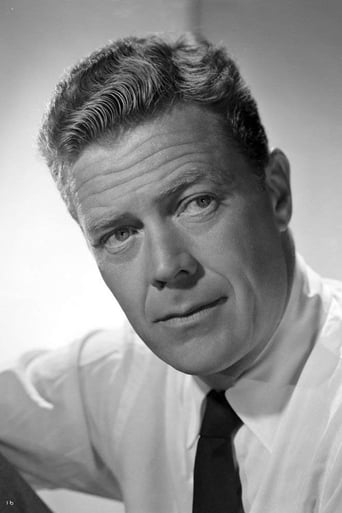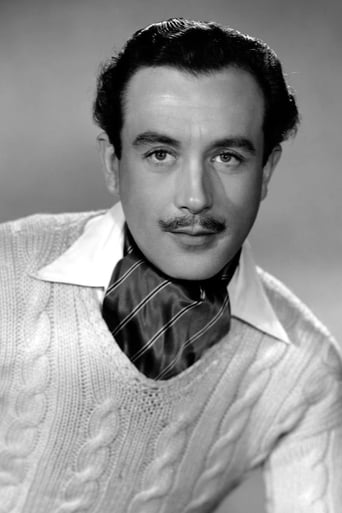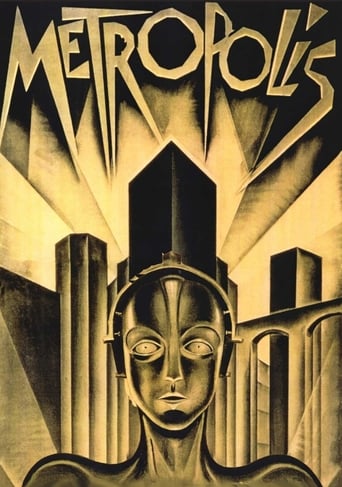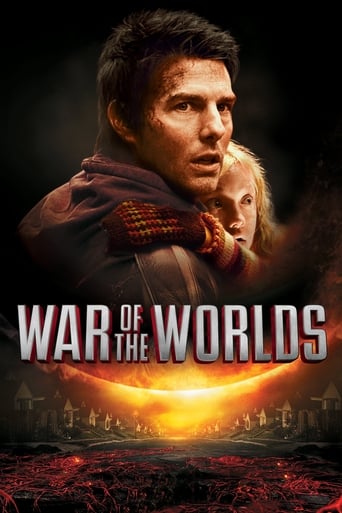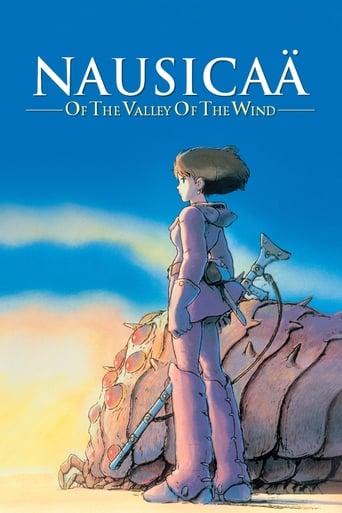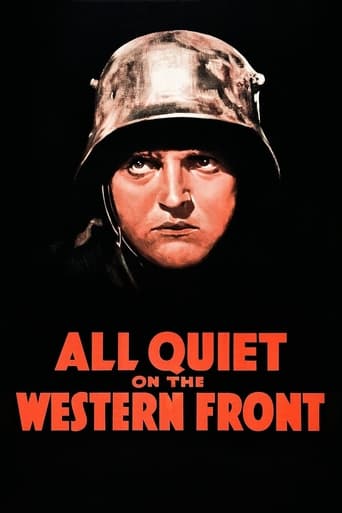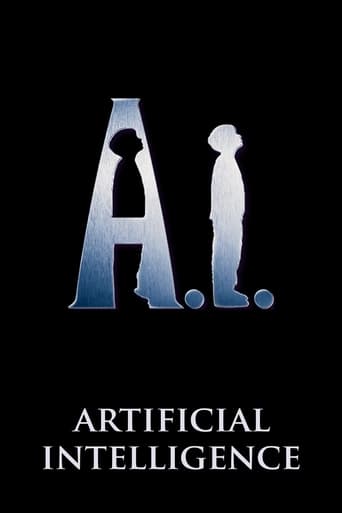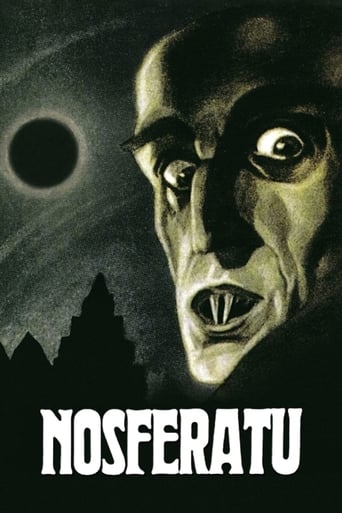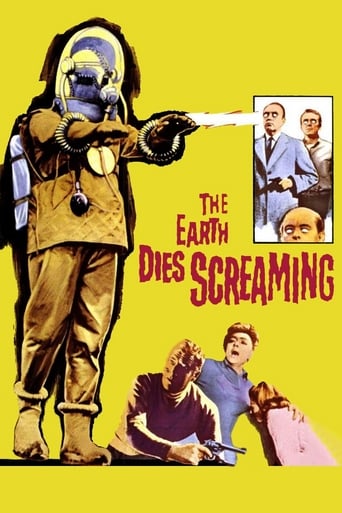
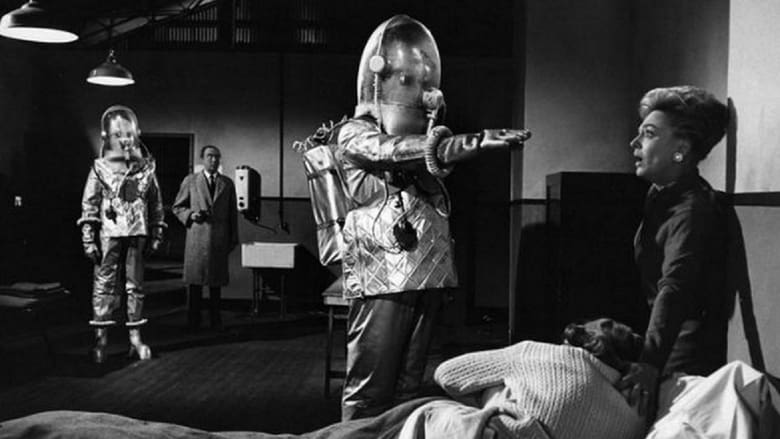
The Earth Dies Screaming (1964)
A crack test pilot lands to find the planet has been devastated by unknown forces. There are a few survivors, so he organizes them in a plan to ward off control by a group of killer robots.
Watch Trailer
Cast
Similar titles

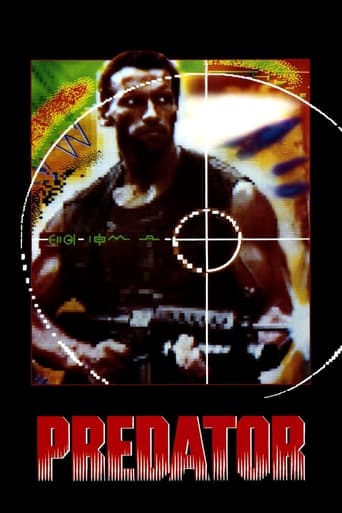
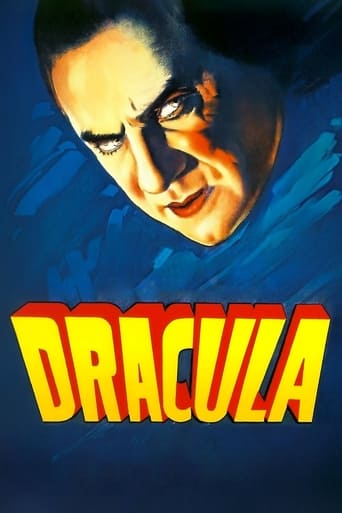
Reviews
Sorry, this movie sucks
Sadly Over-hyped
Don't listen to the Hype. It's awful
One of the worst ways to make a cult movie is to set out to make a cult movie.
Warning, this review contains spoilers.This British made Sci-Fi movie boasts a snappy title, which may be the best part of this film. Aliens attack earth. A small group of survivors hold up in an English village. Their de-facto leader, a test pilot, is played by Willard Parker. Alien invaders wearing what looks like a retro biohazard suit roam the streets. Although unstoppable by pistol and rifle fire, the aliens are not invincible and are shattered to pieces by blunt force trauma from automobiles. I found the acting, stiff, and the film's pace too slow. The dialog was predicable. The mix of survivor characters includes the hero test pilot, a pregnant woman, and a male survivor who drinks too much. Tossed in for good measure the earthlings killed by the aliens, later come to life, controlled by the aliens to do their bidding. So there you have it, a predictable plot, stiff acting, stilted dialog, all packed into a film that is about an hour long. I probably won't be seeing this one again. In fact, I'd like to see the title changed from "The Earth Dies Screaming" to "The Viewers Die of Disinterest".
Unconscious people peacefully slump over the controls of the trains, planes and automobiles they were piloting. This is naturally followed by the crashes of the aforementioned vehicles. A few lone survivors show up and band together as they try to figure things out. The screaming doesn't actually start until some strange space-suited creatures begin slowly lumbering around town and are eventually joined by those they've recently killed.The movie perhaps tries a little harder than comparable films in trying to create a dramatic scenario of survivors dealing with the aftermath of a holocaust they don't understand, but not a lot harder. Plot, character development and dramatic tension are mostly absent and the film plods along nearly as slowly as the completely out-of-place zombies. This may be a low-budget sci-fi film with laughable special effects and an over-the-top title, but the camp value is almost non-existent. On the plus side, its short running time does take some mercy on fans of the genre who feel compelled to see this movie in spite of its limited entertainment potential.
Best Title Ever Saw this film last night and it goes down as a classic noir horror.During the early 60s the Brits make a bunch of truly great horror films which all featured an American hero and great black and white photography. 'These Are the Damned,' 'Bunny Lake Is Missing' just to name a few.'The Earth Dies Screaming' follows a rather typical end of the world zombie horror film. All over England people instantly drop dead. On the quite earth the few survivors start linking up and all realize they survived due to their isolation from the general air during the presumed gas attack.Is the gas attack, natural, foreign, or alien? Are the survivors generally innocent bystanders as they claim or is one of them a spy? To make matters worse the survivors soon encounter killer bullet proof robots in space suits. Even worse and scarier than the robots themselves are their victims whom come back as zombies.At only 60 minutes the film moves at a much faster pace than other quiet earth films. And the scenes are very intense and terrifying. They really do a great job of keeping you on the edge of your seat by their presentation. The zombies may just look like dumb sleep walkers but in the proper presentation they come across as truly terrorizing.Great musical score and photography.
The Earth Dies Screaming starts as something of a misnomer: budget limitations mean we only see the disaster's main effects within a very localised area of Northern England. As for the screaming, there's no human sound heard until 8 minutes into the film. Like many of the small cycle of English invasion films made at this time, Fisher's is small scale, almost domestic in setting, implying a catastrophe at a personal level just as much as on a national one. In contrast to those produced in America, English invasion movies were often less grandiose and paranoid, relying more on alien intrusions into more realistic, even humdrum worlds, places where the ordinary is ever present. Like the cult Devil Girl from Mars (1954) substantial scenes of TEDS take place in the comforting atmosphere of a pub or nearby where, it seems, British folk naturally congregate for comfort and safety: think of Shaun of the Dead's last refuge Director Fisher is most known for the series of Gothic horrors which have most occupied critical attention. His SF work has been readily dismissed as a genre in which he had little interest. TEDS was the first of a trilogy for the appositely named Planet Productions company, the others being Night of the Big Heat (1966) and Island of Terror (1967). All three feature alien invasion and a small group of people trying to fend off the intruders. Negative responses to these works perhaps stem from the fact that, often, the people are more interesting than the monsters and junk science on display, and the films lack the vibrancy of his horror work.At the heart of TEDS are three relationships: that between Quinn Taggart (a splendidly caddish Dennis Price) and Peggy (Virgina Field); the often drunk Otis (Thorley Walters) and his party friend Violet (Vanda Godsell), as well as the young couple Mel (David Spenser) with the pregnant Lorna (Anna Palk). Independent of this group is Jeff Nolan, played by the film's sole American actor. Producer Lippert had a successful formula of adding transatlantic appeal to films by stocking them with token imported talent. Here Willard Packer fits the bill. Packer is the man taking charge of events, organising the survivors, and figuring it out – right down to where the alien's transmitter can be found. He can be seen, in his mild way, as a typical 'Quatermass' figure: a technically competent individual taking charge to protect British society from intrusion. While no pure scientist, Nolan still has enough know-how to quickly grasp what has happened, how the invasion can be thwarted and to take decisive action. By the end of the film, he wins the right to a relationship of his own.Critics such as Peter Hutchings in 'We're All Martians Now' (British Science Fiction Cinema (Routledge, 1999)) have identified such influential figures as typically being a 'boffin-like protector of a society which seems incapable of protecting itself'. At the same time, through the imported novelty of his presence, Nolan is a reminder of British insularity. At time many of these films appeared British society was still relatively isolated, but under pressure from new pressures and changes, both international and local. Only the cynical Taggart has a competing world-view in the film that's as strong as Nolan's. For Taggart the new global conflict is over. Worse, "whoever did it has won its every man for himself" - fatalistic sentiments in stark contrast to the famous spirit of the blitz, striking to many of those watching then. The punishment for his criminality and selfishness will be the loss of his tenuous relationship with Peggy and, ultimately his humanity, part of the alien zombie army.The biggest social change in Fisher's film is obvious – a successful first strike against British society, together with silver-clad aliens walking the streets, zombie workforce in support. Blank-eyed and as slow-moving as their masters, these zombies are among the most effective elements in the film. They must have been rather a novelty to contemporary audiences. I can't, off-hand, think of an earlier representation of the creatures in British cinema before this (Hammer's Plague of the Zombies appeared two years later, but even so is set in the past). They provide one of the highlights of the film – a scene when Peggy is pursued, then trapped breathlessly in a bedroom closet, when Fisher makes use of a very dramatic close up to add terror.In contrast to the unsuccessful efforts of the un-dead to find a female, Nolan succeeds in gradually establishing a relationship and, one presumes, goes on to a successful romance. His success against the invader acts as a catalyst. By the end of the film he is entitled to reintegrate back in society. There's a parallel to be found between the zombie's painfully slow pursuit search and unnerving, soulless staring at the closet in which Peggy hides to another scene where Nolan had looked on, affectionately, as she pottered over small things in the pub's kitchen. The difference between humanity and the alien, the film suggests, is that the former can bring value and sentiment to what it sees and so, once again, the British invasion variant gravitates naturally to the domestic.TEDS is further helped by a very effective score by Elizabeth Lutyens, as well as some crisp, atmospheric cinematography by Arthur Lavis, especially effective when shooting on village location. These are elements that help to make it my favourite out of Fisher's small group of SF movies, a feeling which even the over-acting of Walters can't dissipate. It 's also blessed with a dramatic pre-title sequence - a world wrecked by sudden accident, recalling the night before Day of the Triffids, as well as an eerie sense of a familiar landscape made empty, a horror-fantasy tradition which persists right down to such British films as 28 Days Later. Fisher's film may be short, cheap, and with a disappointingly flat denouement, but its modest pleasures easily invite revival.
